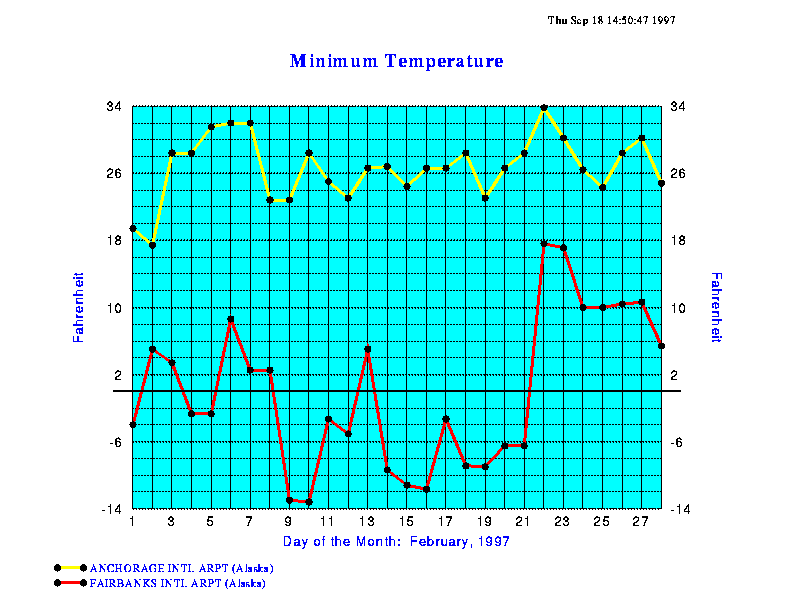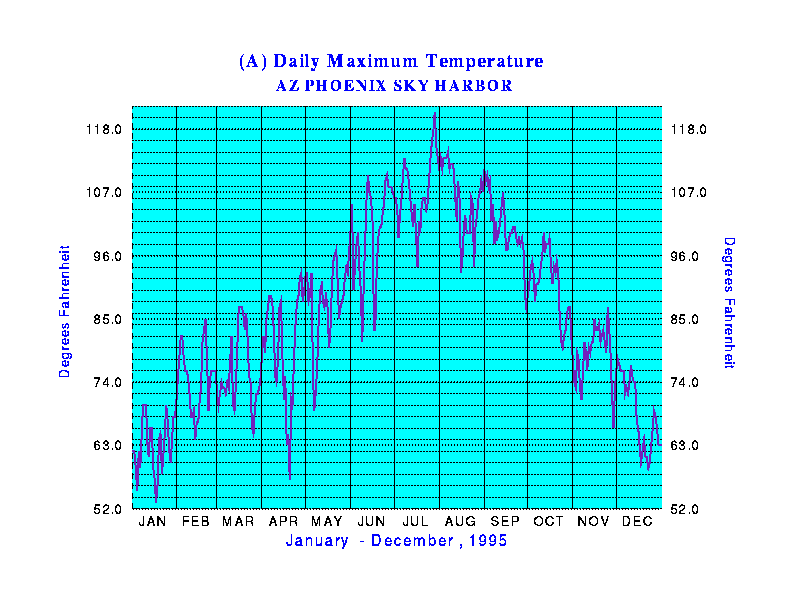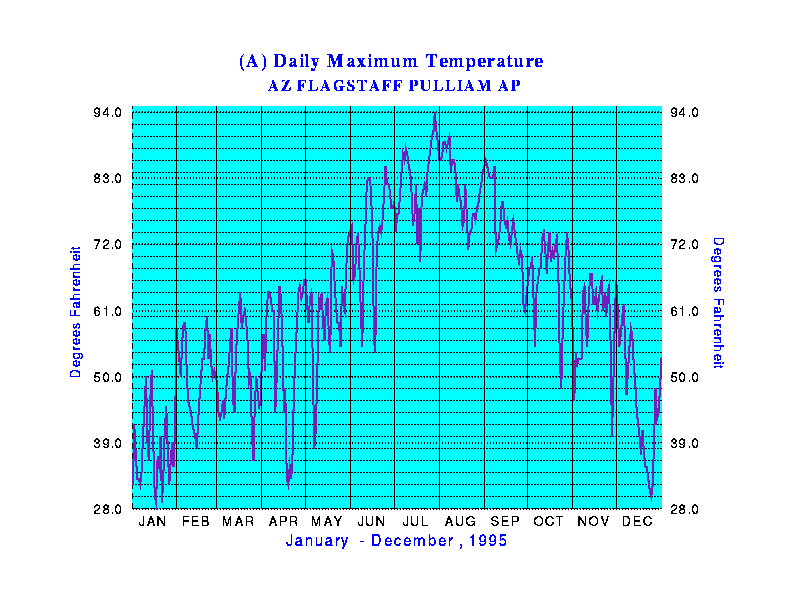
Geography 110H - Fall 1998
Third assignment - for Thursday, Sept. 24
In order to understand the behavior of the atmosphere and oceans and the global pattern of climates, we need first to have some basic understanding of the earth's radiation balance. The components of the radiation balance are discussed in chapter 4 of the textbook. Also discussed are the various processes that may transport energy from one part of the system to another. The global radiation balance not only controls the spatial pattern and annual cycle of temperatures; it also drives the motions of the atmosphere and ocean currents and plays a critical role in the distribution of moisture and precipitation and of storm activity. This week we will take a closer look at aspects of the radiation balance and at patterns of global temperature.
I recommend doing at least the first part of the assignment on Tuesday in class, so that you can discuss what you see and make notes based on that discussion.
It will help you to have read chapters 4 and 5 in Christopherson before proceeding.
1. In order to understand the relationship among the components of the daily radiation balance, consult the web site of the SURFRAD (surface radiation) network, which provides detailed field measurements of each component at five locations from different climatic regions of the U.S. Start by reading the "General information" pages, a set of four pages that explains where the information comes from. Next read the "Site information" pages in order to see the actual locations. After that, go to the "Data Display" page and do the following:
2. Call up the "Wxwise ERBE" Web site. This is a site at the University of Wisconsin at Madison that contains an article discussing the earth's radiation balance. Read the article and look at the images showing global distributions of monthly mean net radiation. View the animated loop showing the annual cycle. (If you can't get the loop to show up as an animation, then look at several individual months spaced over the year.) How is the pattern you see related to the exercise you did last week on seasonal patterns of length of daylight at different latitudes? Also note the comparison between continents and oceans; can you explain the major differences shown?
Next go to the "SSEC Sea Surface
Temperatures" Web site and go to "Latest SST". This is a
beautiful color image showing the global distribution of sea-surface temperature. It is
updated daily. There is an archive containing daily images for the last two weeks, but
unfortunately this site doesn't retain images for long enough to compare patterns showing
seasonal changes. Another site sponsored by NOAA does contain monthly SST
images for the period between 1984 and 1996. Look here in order to see whether
you can pick up any significant changes between images taken a few months apart. How
do they relate to the patterns you observed in the annual cycle of the net radiation
balance? (This is a slow site; if the images take too long to load, don't worry about it.)
Another, faster site with monthly SST images based on long-term average conditions is NOAA's "Live
access to climate data." Note in particular that although temperature
varies mostly with latitude, there are significant anomalies that clearly are affected by
factors other than latitude. Identify one or two such anomalies. What do you think might
explain them?
You can also try another NOAA
site with an animation showing the seasonal cycle of sea-surface temperatures. Or you
might also try looking at the animated view of
sea-surface temperatures for the North Atlantic. This will show you the seasonal cycle
of changing temperatures over a span of about 1.5 years. You can get a fascinating view of
how temperatures reflect not only seasonal cycles of the global radiation balance, but
also the dynamics of the ocean surface itself. An even better view of the same phenomenon
is available in the Ocean Surface
Temperature Movie from NASA. Does this help in answering the question at the end of
the preceding paragraph?
3. Next we are going to focus on changing patterns of temperature over time and space by looking at records from individual stations. Before visiting the next Web site, do the following:
Pick a latitude for comparative study. Locate at least one continental and one maritime location at or close to the same latitude. If you're ambitious you might choose one west-coast location and one east-coast location as well as a continental interior location. This does not have to be limited to sites in the U.S.; there are both U.S. and global data sets available.
You may also choose a pair of stations at different latitudes but comparable maritime or continental interior locations, if you so desire.
Visit the Web site entitled "NCDC Climate Visualization".
Under the heading CLIMVIS Graphics Choices, you will see options for both National Weather
Service Summary of the Day and Global Summary of the Day. Pick whichever one is
appropriate. You have the choice of plotting a time series or a contour map. Start with a
time series option. Select the option that allows you to plot one parameter for a month
from two separate stations in the same region or in separate regions. Pick your stations
and plot both stations together on the same graph for a summer month and a winter month.
(For the summer month pick either mean or maximum daily temperature; for the winter month
pick either mean or minimum daily temperature.) Comment on any patterns that strike you as
interesting or noteworthy. (For example, I tried doing this with Anchorage and Fairbanks,
both in Alaska, using the minimum temperature for February 1997. The results are shown
below. I also tried comparing Asahikawa, Japan with Zamin Ude, Mongolia. Those results are
not shown here; you can look them up for yourself if you wish.)
Afterwards, go back and try a different graph type: "display the period of record
for one parameter at one station" (only works for U.S. stations) or "display one
parameter for a specified time frame" (up to one year; works for U.S. and global data
sets). You can use this to plot temporal variations in maximum, mean, or minimum
temperatures to show seasonal cycles. In the case of the U.S. data set you can also see
multiple years laid out in sequence and get a real feel for year-to-year variation in
temperature patterns. Do this for at least two stations, preferably the ones you have
already been looking at. (Here's an example: I compared maximum daily temperature at
Phoenix and Flagstaff, Arizona for the period January-December 1995. If you want to make
this kind of comparison for non-U.S. stations, you need to choose the "Global
Historical Climatological Network Data" option.)

You can also make contour plots illustrating spatial patterns of climatic variables across the U.S. for specified dates. You might want to try experimenting with this as the contour plots may help to understand the relationship between the temperature trends at the two stations you picked earlier (only works if they are both continental U.S. stations. This is not required.)
Write up some general comments on how the observed patterns do or don't conform to what you would expect based on the book's discussion of factors affecting both seasonal patterns and spatial patterns of global temperature.